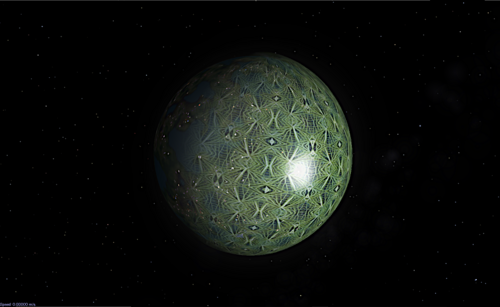Worldhouses (A1-0)
Worldhouses, also known as Worldhouse Roofs, are large, world-sized transparent membranes used on low-gravity worlds that admit starlight in while preventing atmosphere escape.
Structure
Worldhouses have very similar general structures to Dome Habitats, but scaled up hundreds or thousands of times to completely cover the surface of a planet. However, this size increase leads to notable differences in the construction and support of said structures.

Pandifico Worldhouses
Pandifico Worldhouses are the most similar type of worldhouse to Dome Habitats. Their though, flexible membrane is made out of Transparent Elastic Diamondoid Fiber Composites, more commonly known as Pandifico, and is divided into several layers, some of which are filled with smart fluids or gel which actively repair any minor punctures.
Such a worldhouse roof acts as a greenhouse as well, allowing cooler planets to retain enough heat and atmosphere to become habitable for the intended population type. If an additional greenhouse effect is needed, specialized heat-gathering materials and channels can also be constructed. Oppositely, by incorporating a semi-reflective layer these worldhouses can be used closer to the local star, and modern materials can be used which permit the transmission of infrared wavelengths to prevent overheating.
While most worldhouses are kept suspended simply by atmospheric pressure, some thicker worldhouses will need some additional support, that can be given to them through Atlas Pillars, additional aerostatic support, or by Geosynchronous Cable satellites. Depending on thickness, density and total weight, some of these Worldhouses may just need additional support in some specific locations, or they might be so heavy that atmospheric pressure is their secondary support, while a network of equally spaced Atlas Pillars acts as their primary form of support.

Canopy Plants
The Canopy Plant is a neogen terraforming plant with bionano capabilities. The plant's growth follows this basic outline:
- Hardened Seedpods are dropped from planetary orbit. They may be decelerated by parachute or balloon cushion depending on the atmosphere of the target body.
- Pods penetrate the surface or burrow down to their optimal depth.
- Each seedpod begins to extend a root system through the ground and a stellar energy collecting canopy bud to the surface.
- The plant extends its canopy, utilizing material mined from the air and ground. It sends up to three fast growing runners that are separated from one another by approximately 120 degrees. When they reach a preset distance they set down new root systems. The canopy membrane grows out from the taproot and the edges of the runners. As it grows it is initially anchored to the ground by temporary rootlets.
- New root systems produce their own canopy buds and send out their own runners until they begin to link up in a roughly hexagonal network according to local terrain.
- The canopy continues to grow from the vertices and runner edges until it covers an entire hexagon. The air pressure beneath the canopy rises as atmosphere is processed, causing the canopy dome to inflate. Curtain membranes grow between each canopy and runner, sealing each hexagonal cell off from the others. Tailored biota and bionano are then introduced into the cells to further prepare the developing biome.
- As ceiling height increases the curtain walls may be detached, creating ever-greater continuous space beneath the canopy which remains anchored to the surface by the original stems.
- Atmospheric processing and terraforming may continue in the air outside of the canopy domes till the desired composition and pressure are achieved. Air pressure under the canopy may then be equalized with that outside, and the cell canopies rent to expose the cell interiors. The plant's biomass can then be recycled into the new environment. This can be done progressively if adjoining cells remain sealed off by the curtain walls and are kept under higher pressure.The speed of Canopy Plant growth is dependent upon insulation and the composition of the regolith and atmosphere from which the plant draws material. Once the runner network is in place, needed feedstock may be transported through it to where it will be most useful. Starlight can be augmented by orbital mirrors or magnifying solettas and required nutrients and volatiles may be imported if they are deficient in the native environment, unless slower growth or more limited coverage is not an issue to those in charge of the project. Under optimal conditions the area covered by canopy can double every two weeks and an Earth sized planet can be covered in less than 2 years from an initial planting of 10,000 uniformly spaced Seedpods.